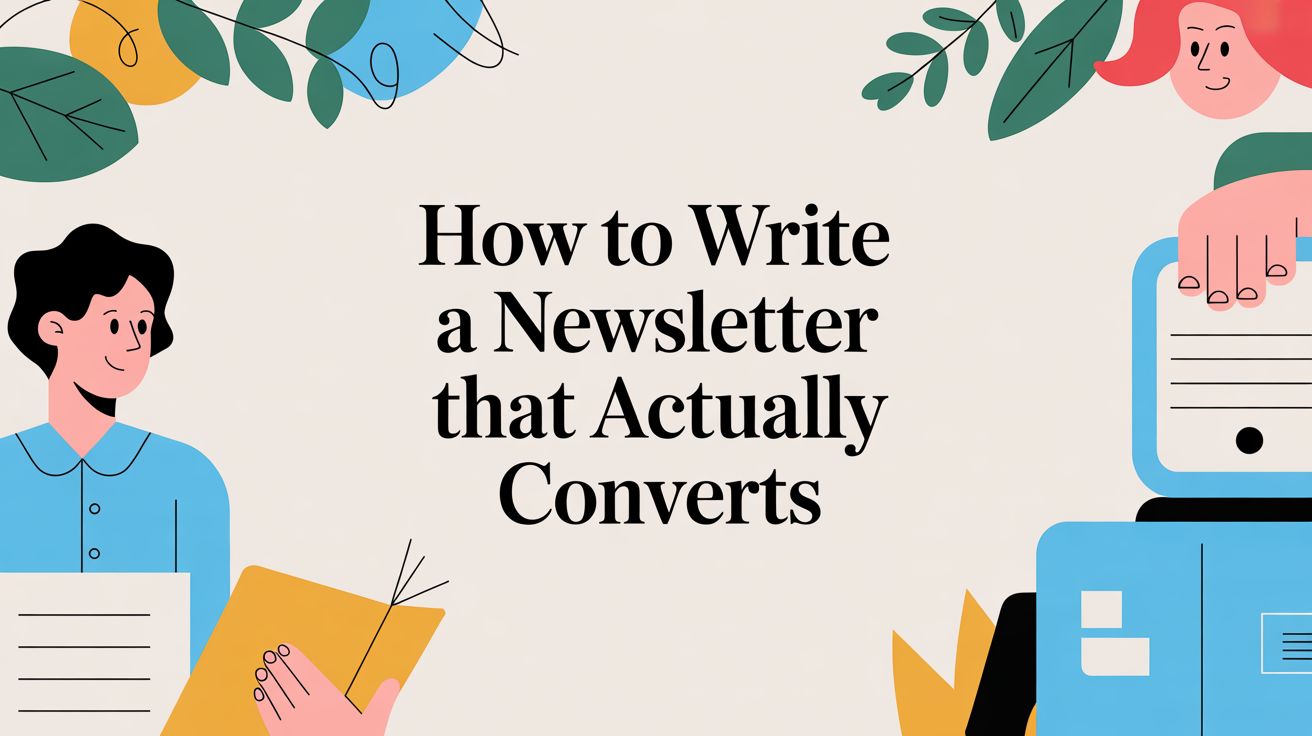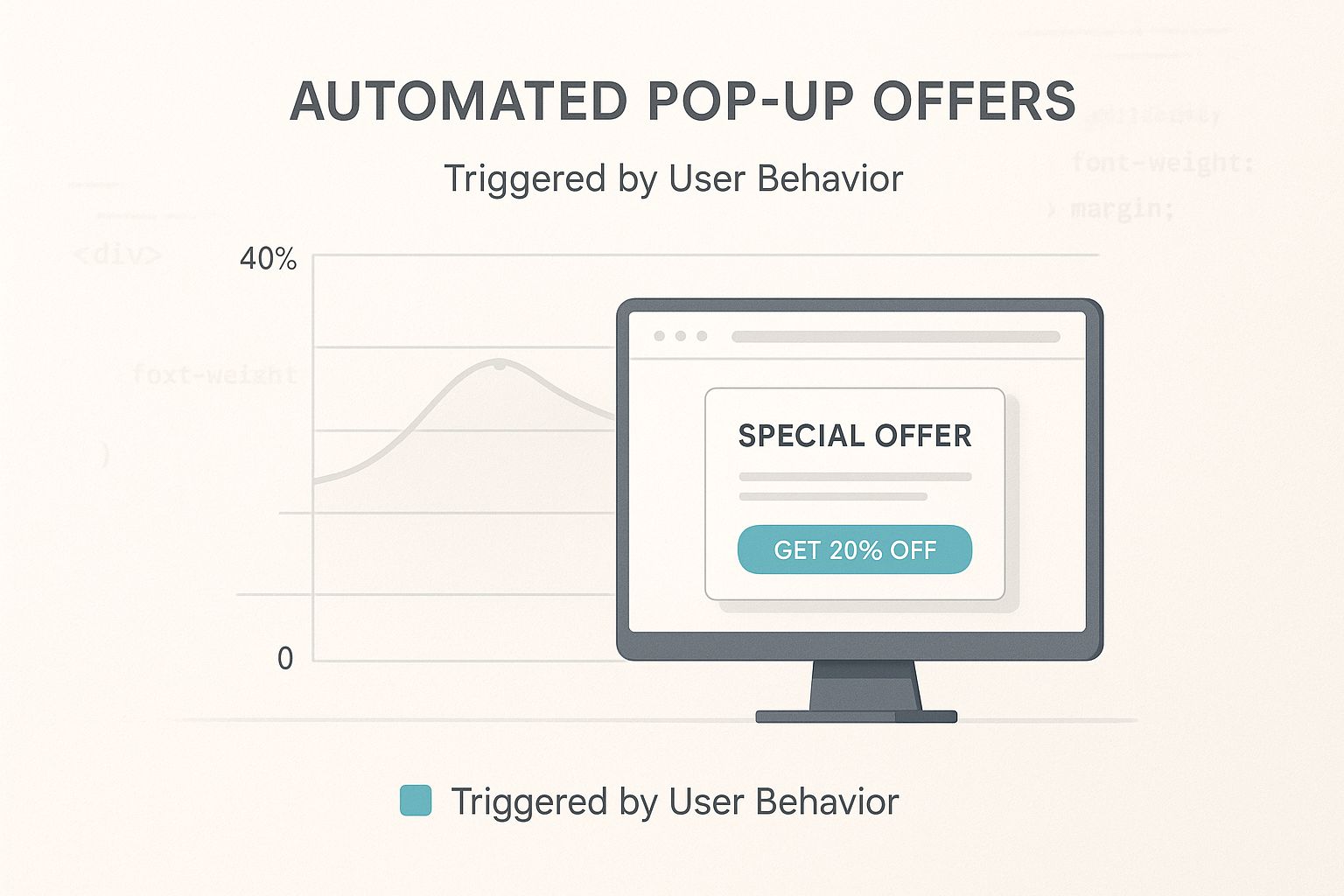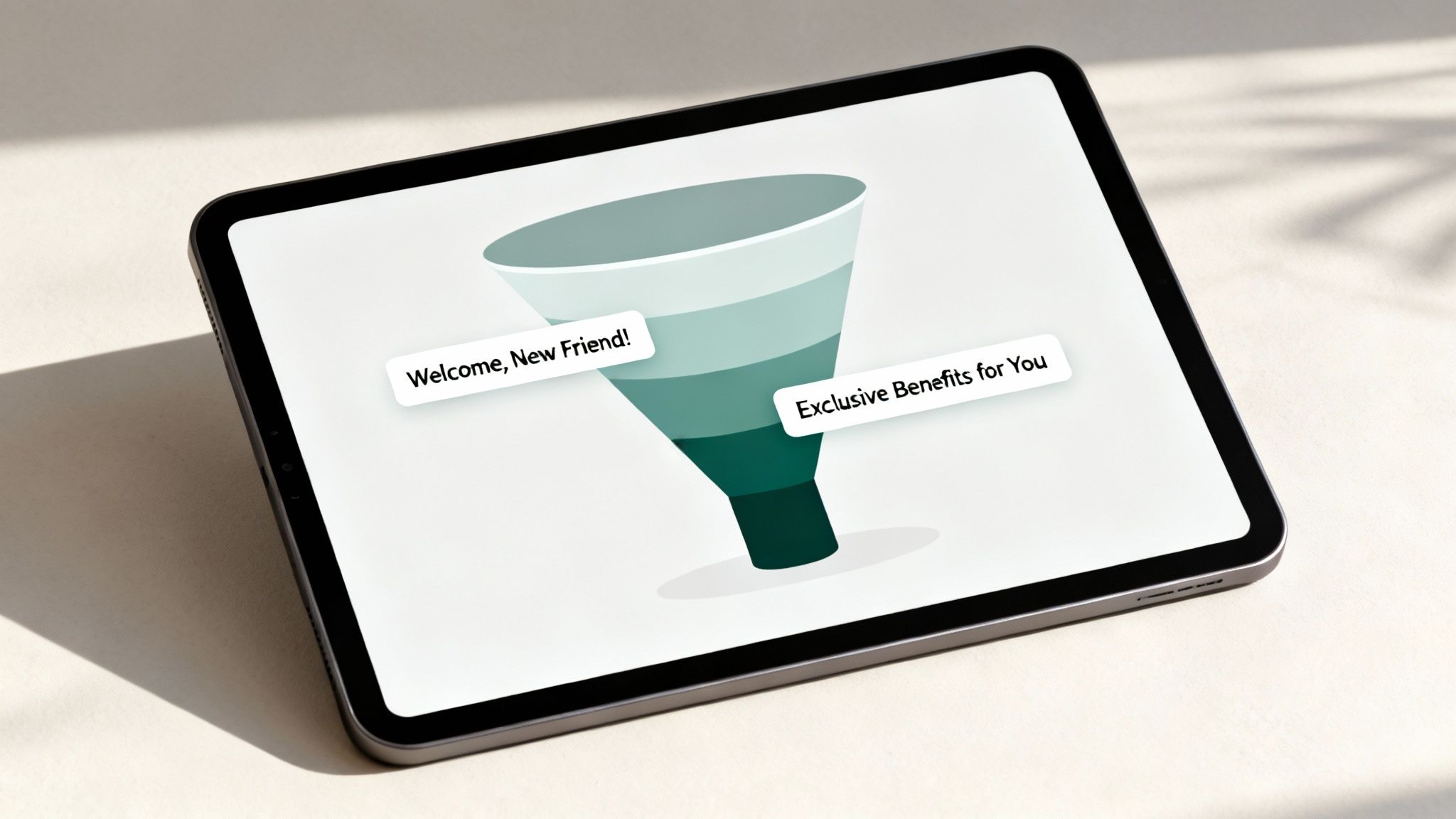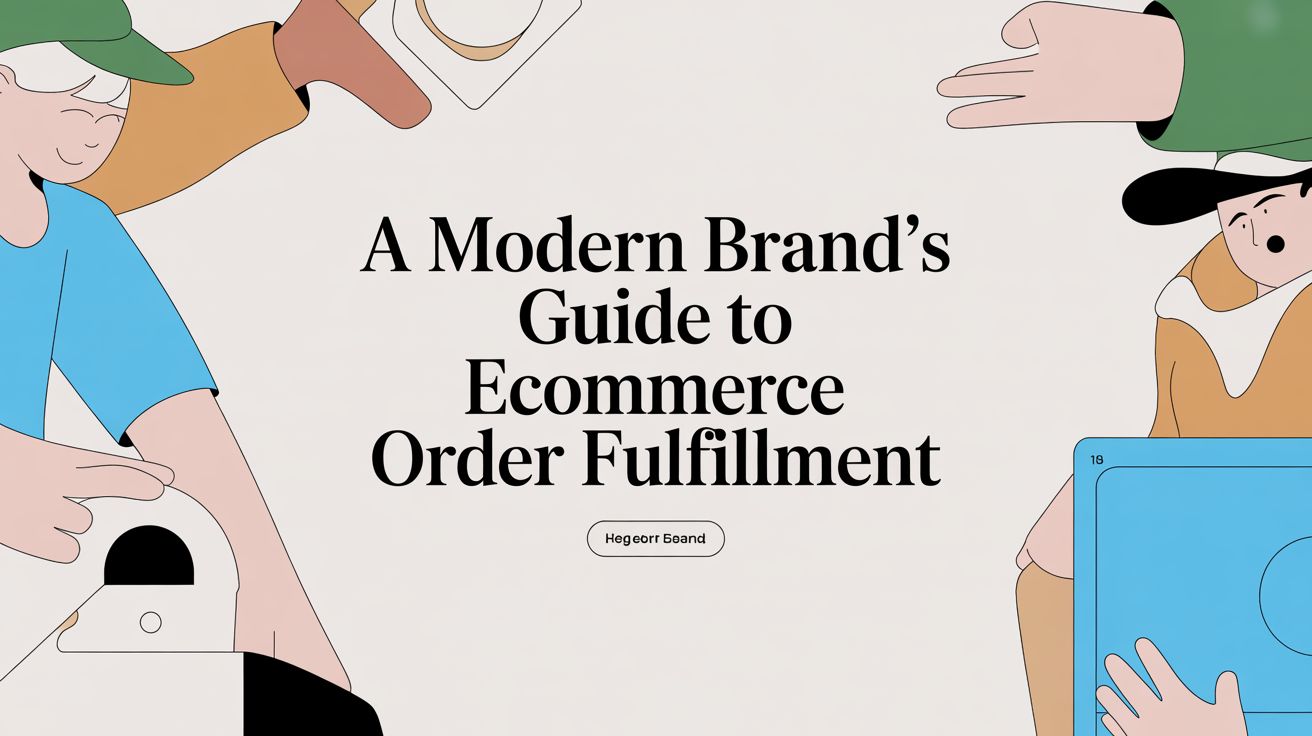
Boost Shopify Sales Today: Proven Strategies to Increase Revenue

If you want to boost your Shopify sales, you must move beyond the standard marketing playbook. While the average ecommerce shop converts somewhere around 2.5% of its visitors, the brands that achieve significant growth understand the behavioral science behind giving customers a compelling reason to buy right now.
It's about applying consumer psychology to transform your product catalog from a simple list of items into a high-performance revenue engine.
Moving Beyond Basics to Boost Shopify Sales
Increasing revenue from your Shopify store requires a strategy deeper than just SEO tweaks or another ad campaign. The key is understanding why people buy. This means ethically applying principles from behavioral economics to your marketing, activating the triggers that guide human decision-making.
This guide moves beyond generic advice to explore the powerful psychological concepts that compel customers to act. Instead of merely showcasing products, you'll learn to architect experiences that drive measurable ROI and protect your profit margins.
Adopting a Psychological Framework
The most successful Shopify merchants understand that a sale isn't just a transaction; it's the culmination of a psychological journey. By mapping and influencing that journey, you can guide customers from "just browsing" to "just bought" far more effectively.
This looks like applying a few core principles from behavioral science:
- Scarcity: Highlighting limited supply to increase perceived value, based on the principle that people desire what is less available. Think "Only 3 left in stock!"
- Social Proof: Using customer reviews, testimonials, and live activity notifications to build trust and demonstrate desirability. When people see others buying, it validates their own potential decision.
- Anticipation: Building genuine excitement around upcoming product launches or exclusive sales events, leveraging the brain's reward system.
When you weave these principles into your Shopify store, buying from you feels like a natural, rewarding choice. To optimize this, you must move beyond basic analytics and use better ad tracking and data-driven decisions to understand what truly motivates your audience.
A psychologically-driven campaign isn't about manipulation. It's about aligning your offers with established consumer motivations. The result? Higher revenue, better inventory control, and stronger brand loyalty.
This approach lets you protect your profit margins by avoiding the race to the bottom with constant, deep discounts. Instead of a basic popup focused solely on email capture, you're building a system that actively generates revenue. A great starting point is exploring the best Shopify marketing apps, many of which are designed to help you implement these advanced, psychology-based tactics.
Harnessing Urgency to Drive Immediate Action
To move the needle on your Shopify sales, you must give customers a reason to buy now. This is where urgency marketing, grounded in science, comes into play. Its true power extends far beyond a generic countdown timer on a product page.
Effective urgency marketing is applied behavioral economics. It’s about tapping into the psychological principles that explain why and when people make purchasing decisions.
By creating authentic "urgency moments," you connect with powerful drivers like loss aversion. This isn't about deception; it's about pairing a valuable offer with a customer's innate desire to avoid missing out. It's a crucial strategy for combating the staggering industry average cart abandonment rate, which sits around a painful 70%. Hesitation is the enemy of conversion.
The Psychology Behind Compelling Offers
The most powerful urgency tactics are a combination of two core behavioral principles:
- Scarcity: The economic principle that limited supply increases demand. An item is inherently more desirable when few are available.
- Fear of Missing Out (FOMO): This taps into the social anxiety that one might miss out on a rewarding experience that others are enjoying.
A basic "offer ends in 24 hours" message barely scratches the surface. To impact revenue, you must layer these principles. A limited-time offer becomes exponentially more powerful when framed with social proof, like a banner showing "200 other shoppers are viewing this deal right now."
This combination instantly transforms a passive browsing session into an active decision-making moment. The customer no longer just sees a discount; they feel the social validation and the tangible possibility of loss, which motivates them to act.
Actionable Takeaway: The goal is to create an environment where the perceived cost of inaction is greater than the cost of the product. This is key to turning consideration into a completed sale, directly impacting your bottom line.
Moving Beyond Basic Timers
Many Shopify apps provide basic countdown timers or pop-ups geared toward email capture. While useful, they lack the sophistication to drive significant revenue. They are static tools in what should be a dynamic, responsive customer journey.
A more advanced approach, engineered by platforms like Quikly, focuses on creating dynamic, personalized "Moments" of urgency. These are not one-size-fits-all campaigns but are triggered by specific shopper behaviors. It's the difference between shouting an offer into a crowded room and delivering a perfectly tailored deal to an interested customer at the ideal moment. You can dive deeper into these advanced Shopify urgency tactics in our detailed guide.
This strategy delivers more than a temporary lift in conversions; it has a real impact on core business metrics:
- Protects Profit Margins: By building perceived value through scarcity, you don't have to rely on deep, margin-killing discounts.
- Improves Inventory Management: Strategically clear out seasonal or slow-moving stock without resorting to clearance sales that devalue your brand.
- Increases ROI: Personalized, behavior-driven campaigns consistently outperform generic ones, leading to a higher return on marketing spend.
Implementing Advanced Behavioral Triggers
It’s time to put consumer psychology into practice on your Shopify store. To truly boost shopify sales, you must move past generic, one-size-fits-all campaigns. The greatest ROI is found in automated, intelligent responses to shopper behavior. This is where advanced behavioral triggers change the game.
Forget manually setting up a sitewide sale. Imagine a system that automatically identifies a high-intent shopper and delivers the perfect incentive at the exact moment of hesitation. This is a practical, revenue-first strategy that converts browsing into buying.

The core concept is shifting from static campaigns to dynamic "Moments" that feel personal and timely. That connection is what directly increases conversion and revenue.
From Static Popups to Dynamic Revenue Triggers
Traditional popups are typically designed for one thing: email capture. While list building is important, these popups often interrupt the shopping experience without contributing to immediate revenue. They are a passive tool for future marketing.
Advanced behavioral triggers, by contrast, are active sales tools designed to convert a shopper now.
Consider this real-world scenario: A customer visits your Shopify store three times in one week, repeatedly viewing the same high-margin product without adding it to their cart. A basic popup would ask for their email. A behavioral trigger recognizes this pattern and launches a Quikly "Moment."
Actionable Takeaway: This "Moment" could be a personalized, single-use offer displayed only to that shopper: "We noticed you're interested! For the next 15 minutes, get this item with free express shipping. Only 2 left at this price."
This is the science of urgency in action, activating several psychological drivers simultaneously:
- Reciprocity: You're offering a personalized benefit based on their demonstrated interest.
- Scarcity: "Only 2 left" makes the item feel more valuable and exclusive.
- Time-Constraint: "Next 15 minutes" creates a powerful reason to act immediately, combating indecision.
You can explore more examples of this strategic use of popups for Shopify.
Integrating Triggers Across Your Marketing Stack
The power of these triggers is amplified when connected to the marketing tools you already use, such as Klaviyo or your preferred SMS platform. This is critical for growing brands and enterprise merchants on Shopify Plus who require seamless automation to scale.
Let's revisit our hesitant visitor. They see the 15-minute offer but still don't convert. An advanced system doesn't let the opportunity vanish.
Instead, an integration with Klaviyo or an SMS tool can trigger an automated follow-up: "Your special offer on the [Product Name] is about to expire." That simple, automated message can be the final nudge needed to close the sale, turning a near-miss into confirmed revenue. This level of automation is essential for running large-scale events like flash sales, allowing Shopify Plus stores to execute complex, high-traffic campaigns that feel personalized to every shopper—without manual oversight. It’s smart automation that boosts conversion while protecting margins by applying discounts surgically instead of through profit-eroding sitewide markdowns.
Optimizing the Entire Customer Journey

One-off campaigns can provide a temporary lift, but sustainable growth requires a holistic view. To consistently boost Shopify sales, every touchpoint must be optimized. This means creating a cohesive, psychologically persuasive experience from the first ad impression to the post-purchase follow-up.
The compelling message in your social media ad cannot evaporate when a visitor lands on your site. The same sense of excitement or urgency must carry through to the product page, cart, and checkout. Disjointed messaging creates friction—a primary driver of cart abandonment.
Personalizing the Experience for Every Visitor
Not all shoppers are the same, so they shouldn't be treated that way. A first-time visitor requires a different conversation than a loyal VIP. Dynamic banners and popups that adapt based on visitor segments are a powerful tool for this.
For example, a new visitor could be greeted with a banner offering 10% off their first order—a classic application of the reciprocity principle. A returning customer might see an exclusive preview of an upcoming collection, reinforcing their VIP status. This personalization makes shoppers feel seen and valued, which is proven to increase conversion rates.
Actionable Takeaway: The most effective Shopify stores don't just sell products; they guide customers through a carefully constructed journey. Each step is an opportunity to reinforce value, build trust, and apply psychological principles that encourage a purchase.
From Abandoned Carts to Recovered Revenue
The checkout process is a notorious sales bottleneck. A high-converting popup tied to an exit-intent trigger can be your last line of defense. Instead of generic "Don't go!" messages, provide a compelling, time-sensitive reason to stay.
Imagine a shopper is about to abandon a full cart. A Quikly "Moment" triggers a popup offering free shipping if they complete their purchase in the next 10 minutes. This intervention tackles a common pain point (shipping costs) while introducing a clear deadline.
The journey doesn't end at purchase. A superior post-purchase experience turns one-time buyers into repeat customers. Use your email and SMS flows to:
- Confirm their order and build anticipation.
- Offer a special discount on a future purchase as a thank you.
- Ask for a review after delivery to generate social proof.
This holistic approach transforms buyers into brand advocates. Shopify's ecosystem is built for this multi-channel engagement. It’s no surprise that 90% of Shopify merchants connect their stores to multiple sales channels. By tapping into the platform's apps, you can automate these personalized journeys. You can read more about the powerful trends driving Shopify's growth on redstagfulfillment.com.
So, you’ve launched urgency campaigns. But how do you know they’re boosting your Shopify sales and contributing to your bottom line? The real win isn’t just a conversion lift; it's measurable revenue and profit growth.
To scale effectively, you must focus on business metrics that tell the complete financial story. The most successful Shopify merchants measure the full impact of their efforts. This data-first mindset proves the direct ROI of your strategy and justifies further investment in what works.
Key Performance Indicators That Actually Matter
To get a true sense of performance, there are a few core KPIs you should monitor closely:
- Average Order Value (AOV): Are your targeted offers simply securing a sale, or are they encouraging customers to add more to their cart? A rising AOV is a clear sign your strategy is adding value to each transaction.
- Customer Lifetime Value (CLV): A good campaign should be the start of a relationship. Tracking CLV reveals whether you're building a loyal customer base or just churning through one-time buyers.
- Profit Margin Protection: Are you clearing out old inventory without resorting to deep, profit-eroding discounts? Controlled urgency allows you to move seasonal stock at healthier price points than a typical clearance sale, directly protecting profitability.
Focusing on these numbers creates a powerful feedback loop, allowing you to double down on the campaigns that drive the most profitable growth.
A Data-Driven Approach to Scaling
Once you have your baseline metrics, you can begin systematic improvement through A/B testing.
Pit different urgency triggers against each other. Does a low stock alert outperform a limited-time offer for your audience? Which drives a bigger increase in AOV? Testing is the only way to know for sure. As you scale, it also becomes critical to measure SEO ROI to understand the full revenue impact of your marketing investments.
This cycle of testing and refining separates high-growth stores from the rest. Shopify's gross merchandise volume recently hit a record $292.3 billion, and with 24% of all ecommerce websites running on the platform, the opportunity is massive, but so is the competition. A data-backed strategy is your competitive advantage. You can dig into more of Shopify's impressive growth on uptek.com.
Actionable Takeaway: By tracking the right KPIs and constantly testing your campaigns, you transform marketing from a cost center into a predictable, scalable revenue engine. This is how you build a resilient and profitable Shopify business.
Common Questions About Shopify Sales Psychology
When merchants explore these advanced strategies, several questions arise. Understanding the nuances of sales psychology is what separates an effective, ethical strategy from a clumsy one. This is about working with natural human behavior to create a better shopping experience, not manipulation.
A common concern is whether urgency marketing will alienate customers. The answer lies in authenticity. When an offer is genuinely limited—due to low stock or a true seasonal promotion—communicating that fact is not deceptive; it's helpful. You are providing the information needed to make an informed decision, a core tenet of behavioral economics.
Is This Approach Too Aggressive For My Brand?
No one wants to feel like they're pressuring customers or damaging their brand reputation. This is where the difference between a basic countdown timer and a smart, behavioral trigger is most apparent. A generic timer that is always ticking down on every page can quickly feel inauthentic and erode trust.
In contrast, a platform like Quikly allows you to create intelligent "Moments" that are far more personal. Imagine offering a one-time shipping upgrade to a loyal customer with a full cart who is showing exit-intent. That’s not an aggressive sales pitch; it's a personalized, value-added incentive. It rewards their intent rather than manufacturing false pressure.
The best psychological marketing doesn't feel like marketing. It feels like a concierge service, anticipating a customer's needs and offering a relevant, timely solution that helps them buy with confidence.
Can This Really Impact My Bottom Line?
It's fair to question if these strategies move beyond conversion rates to affect true ROI. The data is clear. By giving shoppers a compelling reason to buy now, you directly combat the 70% cart abandonment rate that plagues ecommerce. Capturing that otherwise lost revenue is the most immediate bottom-line benefit.
Beyond that, these tactics are instrumental in protecting profit margins. Instead of slashing prices with deep, margin-killing discounts, you build value through scarcity and social proof. This helps you move inventory without devaluing your products.
With the global ecommerce market projected to hit $6.4 trillion, the opportunity for Shopify brands is immense. Optimizing your customer's journey with these psychological principles is how you claim your share. You can explore the explosive growth of global ecommerce on shopify.com to understand the scale of the opportunity.
Ready to turn your Shopify store into a revenue powerhouse? Quikly gives you the advanced tools to use psychology-driven urgency in a way that delivers real business impact. Find out how our platform helps you lift conversions, protect your margins, and build the kind of customer loyalty that lasts.
Learn more at https://hello.quikly.com.

The Quikly Content Team brings together urgency marketing experts, consumer psychologists, and data analysts who've helped power promotional campaigns since 2012. Drawing from our platform's 70M+ consumer interactions and thousands of successful campaigns, we share evidence-based insights that help brands create promotions that convert.
